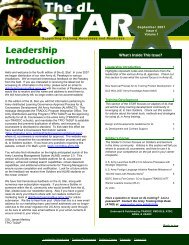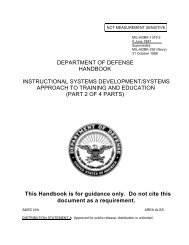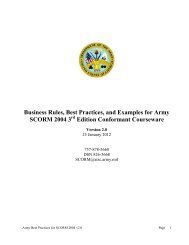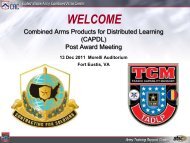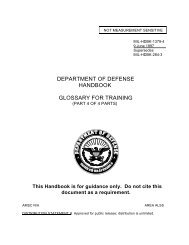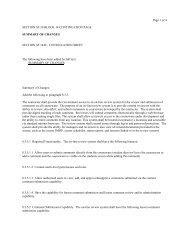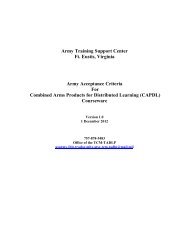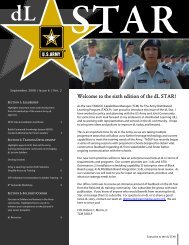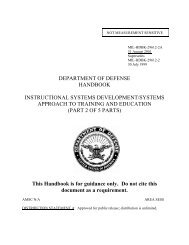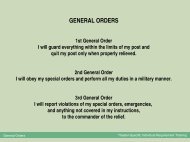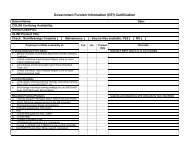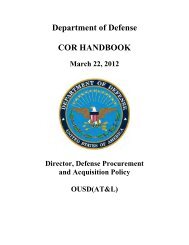MIL-PRF-29612B - U. S. Army Training Support Center
MIL-PRF-29612B - U. S. Army Training Support Center
MIL-PRF-29612B - U. S. Army Training Support Center
- No tags were found...
You also want an ePaper? Increase the reach of your titles
YUMPU automatically turns print PDFs into web optimized ePapers that Google loves.
NOT MEASUREMENT SENSITIVEPERFORMANCE SPECIFICATIONTRAINING DATA PRODUCTS<strong>MIL</strong>-<strong>PRF</strong>-<strong>29612B</strong>31 August 2001SUPERSEDING<strong>MIL</strong>-<strong>PRF</strong>-29612A30 July 1999This specification is approved for use by all Departments and Agencies of the Department ofDefense.1. SCOPE1.1 Scope. This performance specification for training data products (See 6.5.38)establishes data requirements to support the life-cycle maintenance of training data products andis a source document for training (See 6.5.37) related Data Item Descriptions (DIDs). Thisspecification may be used by contractors and the Government in establishing the training datarequirements to be delivered.Beneficial comments (recommendations, additions, deletions) and any pertinent data whichmay be of use in improving this document should be addressed to: Commander, Naval AirWarfare <strong>Center</strong> Aircraft Division, Code 414100B120-3, Highway 547, Lakehurst, NJ 08733-5100, by using the self-addressed Standardization Document Improvement Proposal (DDForm 1426) appearing at the end of this document or by letter.AMSC N7474AREA SESSDISTRIBUTION STATEMENT A: Approved for public release; distribution is unlimited.
<strong>MIL</strong>-<strong>PRF</strong>-<strong>29612B</strong>2. APPLICABLE DOCUMENTS2.1 General. The documents listed in this section are specified in sections 3 and 4 of thisspecification. This section does not include documents cited in other sections of thisspecification or recommended for additional information or as examples. While every effort hasbeen made to ensure the completeness of this list, document users are cautioned that they mustmeet all specified requirements documents cited in sections 3 and 4 of this specification, whetheror not they are listed.2.2 Government documents.2.2.1 Other Government documents, drawings, and publications. The following otherGovernment documents, drawings, and publications form a part of this document to the extentspecified herein. Unless otherwise specified, the issues are those cited in the solicitation.DoD Data Architecture (DDA)Defense Data Dictionary System (DDDS)(The DDA and DDDS can be downloaded from http://www-datadmn.itsi.disa.mil. Toregister for an account, go to http://www-datadmn.itsi.disa.mil/tools.html click on DDDSRegistration.)High Level Architecture (HLA)(The HLA can be downloaded from http://www.ntsc.navy.mil.)Joint Technical Architecture (JTA)(The JTA can be downloaded from http://www-jta.itsi.disa.mil.)2.3 Non-Government publications. The following document(s) form a part of thisdocument to the extent specified herein. Unless otherwise specified, the issues of the documents,which are DoD adopted are those listed in the issue of the Department of Defense Index ofSpecifications and Standards (DoDISS) cited in the solicitation. Unless otherwise specified, theissues of documents not listed in the DoDISS are the issues of the documents cited in thesolicitation.Interactive Multimedia Association Recommended Practices for Interactive CoursewarePortability (not Government adopted)2
<strong>MIL</strong>-<strong>PRF</strong>-<strong>29612B</strong>(Requests for copies should be addressed to the Interactive Multimedia Association, 48Maryland Avenue (Suite 202), Annapolis, MD 21401-8011.)Institute for Electrical and Electronic Engineers (IEEE) 1484.11, IMS EnterpriseInteroperability Best Practices Guide(Application for copies should be addressed to the Institute Of Electrical and ElectronicsEngineers 3 Park Ave, 17 th Floor New York, NY 10016-5997.)International Standards Organization (ISO) 9000, Quality Assurance, Supplement Z1.11,Education and <strong>Training</strong>(Application for copies should be addressed to Global Engineering Documents, Customer<strong>Support</strong>, A105 15 Inverness Way, Englewood, CO 80112 and can also be accessed athttp://www.iso.ch.)2.4 Order of precedence. In the event of a conflict between the text of this document andthe references cited herein, the text of this document takes precedence. Nothing in thisdocument, however, supersedes applicable laws and regulations unless a specific exemption hasbeen obtained.3. REQUIREMENTS3.1 General. The contractor shall use, to the maximum extent possible, all previouslydeveloped data that can be applied toward satisfying the data requirements of this specification.This includes Government furnished data and data developed by the contractor incident to othercontractual requirements.3.1.1 Front matter. The content of front matter (See 6.5.12) for specified training dataproducts shall conform to Appendix A of this document, except for the <strong>Training</strong> Conduct<strong>Support</strong> Document.3.2 <strong>Training</strong> data product performance requirements. The training data products shallsupport personnel performance requirements. The training data products shall provide theinformation necessary to support attainment of the physical and mental skills and attitudesrequired for mission accomplishment. The performance requirements associated with eachtraining data product and its associated DID (See 6.3) are as follows:3.2.1 <strong>Training</strong> situation document. This training data product shall provide specific datanecessary to verify the efficiency of a training system (See 6.5.42) to meet existing training3
<strong>MIL</strong>-<strong>PRF</strong>-<strong>29612B</strong>needs, training programs survey results data, and analysis results information on technologiesapplicable to new training needs.3.2.2 Instructional performance requirements document. This training data product shallprovide specific personnel performance requirements data necessary to support the design of atraining program.3.2.3 Instructional media requirements document. This training data product shall providespecific data necessary for the development of instructional media (See 6.5.14).3.2.4 Instructional media design package. This training data product shall provide baselinerequirements data necessary for the development and production of courseware (See 6.5.7).3.2.5 <strong>Training</strong> program structure document. This training data product shall provideinformation necessary for the acquisition of resources for the conduct of training. It shall alsoprovide information necessary for training implementation management.3.2.6 Course conduct information package. This training data product shall provide datarequired by the Government for outsourcing (See 6.5.24) the conduct of training. This productshall provide sufficient information for an accurate evaluation of a student’s (See 6.5.33)capabilities to meet all learning objectives of a course (See 6.5.4) and shall identify prerequisite(See 6.5.25) knowledge and skills (See 6.5.30) of students entering the course. This productshall inform students of the training syllabus, organization, operation, scheduling, and otherpertinent information. This product shall also provide information on an evaluation of a trainee’s(See 6.5.36) performance, the trainee evaluation of training, and shall provide the trainee with acertificate of training.3.2.7 <strong>Training</strong> conduct support document. This training data product shall providedefinition and direction for instructors and trainees for the conduct of formal training. Thisproduct also supports the trainee’s mastery of knowledge, skills, and attitudes for a given subject.3.2.8 <strong>Training</strong> evaluation document. This training data product shall provide specificrequirements data necessary to determine the effectiveness and Return On Investment (ROI) oftraining.3.2.9 Test package. This training data product shall provide specific data necessary for theexamination of an individual’s or unit’s knowledge, skills, attitudes, and achievement of learningobjectives (See 6.5.19) or performance standards.3.2.10 Instructional media package. This training data product shall provide specific datanecessary to support the transfer of knowledge, skills, and attitudes by use of instructional media.4
<strong>MIL</strong>-<strong>PRF</strong>-<strong>29612B</strong>3.2.11 <strong>Training</strong> system support document. This training data product shall provide specificdata necessary for the operation and life-cycle software configuration management of a trainingsystem.3.2.12 Standard digital data. Standard digital data (See 6.5.32) shall contain recordedsource information necessary to support the development of training data products. It shallprovide the basis for training program life-cycle configuration management and controlfunctions. Standard digital data shall be electronically transferable and re-usable amongServices, industry, platforms, and programs. Standard digital data shall contain digital data filetable relationships and data table attributes that conform to the requirements specified in the DoDData Architecture (DDA) (See 6.5.11) and the Defense Data Dictionary System (DDDS) (See6.5.10).4. VERIFICATION4.1 Classifications of inspections. This specification provides two types of verification(Type A and Type B), which can be used for the verification of training data products.Acceptable evaluation criteria values shall be as specified in the contract. The inspectionrequirements specified herein are classified as follows:a. <strong>Training</strong> data product accuracy and completeness verification procedures (See 4.2.1).b. <strong>Training</strong> data product life-cycle maintenance verification procedures (See 4.2.2).4.2 <strong>Training</strong> data product accuracy verification. Verification Types A and B, listed below,shall be used to verify the accuracy, completeness, and life-cycle maintenance capability of eachtraining data product as specified in the contract. Each verification type involves two steps: 1)examine the product to determine the percentage of accuracy and, 2) evaluate the results of theexamination conducted in step one to determine that the evaluation criteria values specified in thecontract are met. Examine and evaluate – these words are used throughout this section and are tobe viewed as separate but related steps of the verification process. The quantity of training datato be examined and the evaluation criteria values (stated as a percentage or as pass/fail) shall beas specified in the contract. Equipment hazard, personnel safety, and environmental related datashall be examined for 100% accuracy. The evaluation will be a review of the examination resultsand a determination as to whether the training data product meets, exceeds, or fails to meet theevaluation criteria values (stated as a percentage or pass/fail) as stated in the contract. TheGovernment maintains the right to re-examine data to ensure its integrity. Verificationrequirements and the criteria for determining performance are as follows:5
<strong>MIL</strong>-<strong>PRF</strong>-<strong>29612B</strong>4.2.1 <strong>Training</strong> data product accuracy and completeness verification procedures (Type A).Examination and evaluation of the data contained in the training data product shall verifyaccuracy and completeness as follows:a. Step 1: Examinations shall confirm traceability of the training data to the mission anddesign parameters. Examinations shall determine a percentage of accuracy for the datathat was examined. The quantity of training data to be examined for completeness, scopeof coverage, comprehensiveness, clarity, logical sequence, accuracy, and references shallbe as specified in the contract.b. Step 2: Evaluations shall validate the integrity of the data. Evaluations shall determine ifthe results of the examination meet contract requirements. Results of the examinationsshall be evaluated during progress reviews, acceptance inspections, course trials (See6.5.6), and small group trials (See 6.5.31) as specified in the contract.4.2.2 <strong>Training</strong> data product life-cycle maintenance verification procedures (Type B).Examination and evaluation of the data contained in the training data product shall verify datalife-cycle maintenance capability (See 6.5.23) as follows:a. Step 1: Examinations shall confirm that an audit trail exists among the training dataproduct, other training data products, and the mission/system configuration.Examinations shall determine a percentage of accuracy for the data that was examined.The quantity of data to be examined for the existence of an audit trail, shall be asspecified in the contract.b. Step 2: Evaluations shall validate the integrity of the audit trail. Evaluations shalldetermine if the results of the examination meet contract requirements. Results of theexaminations shall be evaluated during progress reviews, acceptance inspections, coursetrials, and small group trials, as specified in the contract.4.2.3 <strong>Training</strong> data product performance requirements/verification criteria cross-reference.Table I provides a cross-reference between the Section 3 performance requirements paragraphand the corresponding Section 4 verification criteria paragraph for each training data product.TABLE I. Performance requirements/verification criteria cross-reference.TRAINING DATA PRODUCT <strong>MIL</strong>-<strong>PRF</strong>-29612Performance<strong>MIL</strong>-<strong>PRF</strong>-29612Verification CriteriaRequirements<strong>Training</strong> situation document 3.2.1 4.3.1Instructional performance requirements3.2.2 4.3.2documentInstructional media requirements document 3.2.3 4.3.3Instructional media design package 3.2.4 4.3.46
<strong>MIL</strong>-<strong>PRF</strong>-<strong>29612B</strong><strong>Training</strong> program structure document 3.2.5 4.3.5Course conduct information package 3.2.6 4.3.6<strong>Training</strong> conduct support document 3.2.7 4.3.7<strong>Training</strong> evaluation document 3.2.8 4.3.8Test package 3.2.9 4.3.9Instructional media package 3.2.10 4.3.10<strong>Training</strong> system support document 3.2.11 4.3.11Standard digital data 3.2.12 4.3.124.3 Data product performance verification. Specific examination and evaluationrequirements for each of the training data products are as follows:4.3.1 <strong>Training</strong> situation document. The following verification procedures shall beperformed for the training situation document:4.3.1.1 <strong>Training</strong> situation document - Type A. Examinations and evaluations shall beperformed as follows:a. Examine the data that describes the existing training situation to determine that it issufficient to support the conduct of a situation analysis. Evaluate the data using apass/fail method as specified in the contract.b. Examine the training situation analysis data to determine that the impact statementsprovide an accurate description of the specific resource deficiencies or excesses caused bythe situation. Evaluate the level of accuracy determined during the examination againstthe required percentage of accuracy as specified in the contract.c. Examine the training situation analysis data to determine that the recommendationssupport the most cost effective alternative. Evaluate the data using a pass/fail method asspecified in the contract.d. Examine the training technology assessment data to determine if similar systems thatwere analyzed had features applicable to the new training requirement. Evaluate the levelof accuracy determined during the examination against the required percentage ofaccuracy as specified in the contract.e. Examine the training technology assessment data to determine if the simulation andinstructional features list provides the optimal mix of training equipment (See 6.5.39)required to support the training under study. Evaluate the level of accuracy determinedduring the examination against the required percentage of accuracy as specified in thecontract.f. Examine the training situation data to determine that the situations/events/occurrence(s)are correctly matched to the resources affected. Evaluate the data using a pass/failmethod as specified in the contract.7
<strong>MIL</strong>-<strong>PRF</strong>-<strong>29612B</strong>g. Examine the analytical methods and procedures data to determine that the process to beused supports identification of system requirements. Evaluate the data using a pass/failmethod as specified in the contract.h. Examine the data used as sources of information to determine that the sources support theidentification of solutions and alternatives. Evaluate the data using a pass/fail method asspecified in the contract.i. Examine the solutions and alternatives data to determine that it will support identificationof a cost effective recommendation. Evaluate the data using a pass/fail method asspecified in the contract.j. Examine the data contained in the appendices to determine it is in sufficient detail tocomplement the training situation analysis data. Evaluate the data using a pass/failmethod as specified in the contract.k. Examine the commonality analysis data to determine traceability to the associatedtraining and training equipment. Evaluate the data using a pass/fail method as specifiedin the contract.l. Examine the state-of-the-art assessment data to determine that the capabilities identifiedare applicable to the training requirement. Evaluate the data using a pass/fail method asspecified in the contract.m. Examine the content of the front matter to determine that it conforms to the requirementsof <strong>MIL</strong>-<strong>PRF</strong>-29612 Appendix A. Evaluate the data using a pass/fail method as specifiedin the contract.n. Examine the ROI data to determine that the up-front investment costs are traceable toelements identified in the recommended solutions to the training situation, and that allcost factors (equipment, personnel, training time, etc.) are considered. Evaluate the datausing a pass/fail method as specified in the contract.o. Examine the System Requirements Document to determine that the recommendedtraining system design identifies equipment with High Level Architecture (HLA) (See6.5.13) requirements capability. Evaluate the data using a pass/fail method as specified inthe contract.4.3.2 Instructional performance requirements document. The following verificationprocedures shall be performed for the instructional performance requirements document:4.3.2.1 Instructional performance requirements document - Type A. Examinations andevaluations shall be performed as follows:a. Examine the document to determine whether training program design parameters aretraceable to specific program mission elements to be supported by the training. Evaluatethe level of accuracy determined during the examination against the required percentageof accuracy as specified in the contract.8
<strong>MIL</strong>-<strong>PRF</strong>-<strong>29612B</strong>Evaluate the level of accuracy determined during the examination against the requiredpercentage of accuracy as specified in the contract.l. Examine the Personnel Performance Profile (PPP) item number to determine if it reflectsthe correct knowledge and skill category. Evaluate the data using a pass/fail method asspecified in the contract.4.3.2.2 Instructional performance requirements document - Type B. Examinations andevaluations shall be performed as follows:a. Examine the training task selection criteria to determine that the data will supportidentification of tasks that require training. Evaluate the data using a pass/fail method asspecified in the contract.b. Examine the task titles to determine that they are representative of the task descriptions.Evaluate the data using a pass/fail method as specified in the contract.c. Examine the training data matrix to determine that the tasks are associated with thecorrect system/subsystem/equipment level. Evaluate the data using a pass/fail method asspecified in the contract.d. Examine the task information summary and clarification data to determine that the tasksare properly qualified. Evaluate the data using a pass/fail method as specified in thecontract.e. Examine the training task data to determine that it provides sufficient detail to developlearning objectives which will support the design of training courses. Evaluate the datausing a pass/fail method as specified in the contract.f. Examine the learning objective data to determine that it will support the trainingrequirement. Evaluate the data using a pass/fail method as specified in the contract.g. Examine the knowledge, skills, and attitudes data to determine that it will supportdevelopment of learning objectives and course design. Evaluate the data using a pass/failmethod as specified in the contract.h. Examine Mission Performance Standards (MPS) data to determine that it supportsevaluating personnel capability to perform a mission. Evaluate the data using a pass/failmethod as specified in the contract.i. Examine the Individual <strong>Training</strong> Standards (ITS) data to determine that it will supportdevelopment and/or maintenance of occupational field management documentation.Evaluate the data using a pass/fail method as specified in the contract.j. Examine the content of the front matter to determine that it conforms to the requirementsof <strong>MIL</strong>-<strong>PRF</strong>-29612 Appendix A. Evaluate the data using a pass/fail method as specifiedin the contract.k. Examine the quantity of data relating to the audit trail among performance tasks, learningobjectives, and media as specified in the contract. Evaluate the results of theexaminations during acceptance inspections and course trials to verify data life-cyclemaintenance capability as specified in the contract. Evaluate the level of accuracy10
<strong>MIL</strong>-<strong>PRF</strong>-<strong>29612B</strong>determined during the examination against the required percentage of accuracy asspecified in the contract.4.3.3 Instructional media requirements document. The following verification proceduresshall be performed for the instructional media requirements document:4.3.3.1 Instructional media requirements document - Type A. Examinations andevaluations shall be performed as follows:a. Examine the media selection model data to determine its capability to support theidentification of cost effective media for the specified training requirement. Evaluate thedata using a pass/fail method as specified in the contract.b. Examine the instructional media requirements document to determine whether theinstructional media delivery system recommendations are traceable to specific missionelements. Evaluate the level of accuracy determined during the examination against therequired percentage of accuracy as specified in the contract.c. Examine the cost effectiveness and alternative analysis study results to determine thatresults are accurately reflected in the recommendations for primary and alternateinstructional media delivery systems. Evaluate the data using a pass/fail method asspecified in the contract.d. Examine the data concerning alternatives to determine whether each alternativeconsidered will support the training requirement. Evaluate the data using a pass/failmethod as specified in the contract.e. Examine the sensory stimulus (See 6.5.28) requirements to determine their accuracy andcompleteness for supporting each of the specified learning objectives. Evaluate the levelof accuracy determined during the examination against the required percentage ofaccuracy as specified in the contract.f. Examine the recommended instructional media delivery system data to determine thecapability to support the learning objective stimulus requirements. Evaluate the level ofaccuracy determined during the examination against the required percentage of accuracyas specified in the contract.g. Examine the instructional media delivery system functional characteristics data todetermine the traceability to the sensory stimulus requirement. Evaluate the level ofaccuracy determined during the examination against the required percentage of accuracyas specified in the contract.h. Examine the functional characteristics data to determine whether the characteristics arestated in performance terms. Evaluate the level of accuracy determined during theexamination against the required percentage of accuracy as specified in the contract.i. Examine the training system modification data to determine that all training deficienciesare satisfied. Evaluate the data using a pass/fail method as specified in the contract.11
<strong>MIL</strong>-<strong>PRF</strong>-<strong>29612B</strong>j. Examine the media selection analysis data to determine that the primary and alternatemethods and media support the instructional media requirements. Evaluate the level ofaccuracy determined during the examination against the required percentage of accuracyas specified in the contract.k. Examine the Pre-Planned Product Improvement data to determine that the plan for thetraining system upgrade is supportable. Evaluate the data using a pass/fail method asspecified in the contract.l. Examine the training systems support considerations data to determine that the concepts,goals, and constraints that will control the design of media are supportable. Evaluate thedata using a pass/fail method as specified in the contract.m. Examine the data contained in the appendices to determine it is in sufficient detail tocomplement the instructional media requirements document. Evaluate the data using apass/fail method as specified in the contract.n. Examine the content of the front matter to determine that it conforms to the requirementsof <strong>MIL</strong>-<strong>PRF</strong>-29612 Appendix A. Evaluate the data using a pass/fail method as specifiedin the contract.o. Examine the functional characteristics data to determine whether Joint Serviceinteroperability is to be achieved using HLA and JTA specifications. Evaluate the datausing a pass/fail method as specified in the contract.p. Examine the media selection analysis data to determine the requirements for capability tosupport courseware object interoperability across platforms and systems, reusability, andInternet protocol compatibility have been considered. Evaluate the data using a pass/failmethod as specified in the contract.q. Examine media selection analysis data to determine the requirements for capability foroperating the course using various Learning Management Systems (LMS) (See 6.5.18)have been considered. Evaluate the data using a pass/fail method as specified in thecontract.4.3.4 lnstructional media design package. The following verification procedures shall beperformed for the instructional media design package:4.3.4.1 lnstructional media design package - Type A. Examinations and evaluations shallbe performed as follows:a. Examine the summary description of the training program data to determine if resourcesrequired to operate the instructional media package can be provided by the Government.Evaluate the data using a pass/fail method as specified in the contract.b. Examine the courseware design strategy to determine that all critical elements have beenaddressed. Evaluate the data using a pass/fail method as specified in the contract.12
<strong>MIL</strong>-<strong>PRF</strong>-<strong>29612B</strong>c. Examine the lesson strategy to determine its ability to support the development oflessons. Evaluate the level of accuracy determined during the examination against therequired percentage of accuracy as specified in the contract.d. Examine the lesson strategy and resulting prototype lesson to determine if the prototypelesson conforms to the lesson format guide (See 6.5.21). Evaluate the level of accuracydetermined during the examination against the required percentage of accuracy asspecified in the contract.e. Examine the lesson design strategies for traceability to the applicable learning objective,and the scope of lesson strategies for appropriateness to the related task learningdifficulty. Evaluate the level of accuracy determined during the examination against therequired percentage of accuracy as specified in the contract.f. Examine the lesson strategy for traceability to the courseware development process.Evaluate the level of accuracy determined during the examination against the requiredpercentage of accuracy as specified in the contract.g. Examine the remediation design criteria (See 6.5.27) and branching design criteria (See6.5.2) to determine whether they allow for differences in learning processes. Evaluate thelevel of accuracy determined during the examination against the required percentage ofaccuracy as specified in the contract.h. Examine the performance tracking control features to ensure sufficient features areincluded to obtain all information necessary for student tracking and progress reporting.Evaluate the level of accuracy determined during the examination against the requiredpercentage of accuracy as specified in the contract.i. Examine the courseware logic flow diagrams (See 6.5.9) to determine that the diagramscontain sufficient data to support the development of courseware. Evaluate the level ofaccuracy determined during the examination against the required percentage of accuracyas specified in the contract.j. Examine the content of the front matter to determine that it conforms to the requirementsof <strong>MIL</strong>-<strong>PRF</strong>-29612 Appendix A. Evaluate the data using a pass/fail method as specifiedin the contract.k. Examine the description of Sharable Content Objects (SCO) (See 6.5.29) specificationsand metadata tagging requirements to determine that it contains data necessary to supportcourseware object interoperability across platforms and systems, reusability, and Internetprotocol compatibility. Evaluate the data using a pass/fail method as specified in thecontract.l. Examine the description of the level of granularity and the rationale to determine that thegranularity to be applied supports re-use of the data within the lesson.m. Examine the list of the metadata tags required for each SCO in final deliverable format(i.e., compressed or uncompressed) to determine whether the proposed metadata tags arecomplete and accurate and are sufficient to produce SCOs of an element of the course orlesson. Evaluate the data using a pass/fail method as specified in the contract.13
<strong>MIL</strong>-<strong>PRF</strong>-<strong>29612B</strong>n. Examine the list of the metadata tags required for each original uncompressed formatmedia object to determine whether the proposed metadata tags are complete and accurateand are sufficient to produce SCOs. Evaluate the data using a pass/fail method asspecified in the contract.4.3.4.2 Instructional media design package - Type B. Examinations and evaluations shallbe performed as follows:a. Examine the lesson design data to determine the requirements for SCOs comply withIEEE 1484.11, ISO 9000 Z1.11, applicable Advanced Transmission Systems Committee(ATSC), and Moving Pictures Experts Group (MPEG) specifications, and metadatatagging requirements. These specifications must support courseware objectinteroperability, reusability, and Internet protocol compatibility across platforms andsystems. Evaluate the data using a pass/fail method as specified in the contract.b. Examine courseware design strategy to determine if the Course Structure Format (CSF)hierarchy, sub-structure, sequencing, global properties, SCOs, external references, andmetadata tagging conventions reflect capability for operating the course using the specificLMS. Evaluate the data using a pass/fail method as specified in the contract.4.3.5 <strong>Training</strong> program structure document. The following verification procedures shall beperformed for the training program structure document:4.3.5.1 <strong>Training</strong> program structure document - Type A. Examinations and evaluations shallbe performed as follows:a. Examine the training planning data to determine that the training needs and trainingstrategies support mission requirements by course, training program, and Servicecomponent for peacetime and mobilization. Evaluate the level of accuracy determinedduring the examination against the required percentage of accuracy as specified in thecontract.b. Examine the training planning data (including justification and impact) to determine thatit is traceable to mission needs and training requirements. Evaluate the level of accuracydetermined during the examination against the required percentage of accuracy asspecified in the contract.c. Examine training planning data concerning the milestone schedules to determine whetherproposed milestone schedules support the parent program schedules. Evaluate the datausing a pass/fail method as specified in the contract.d. Examine the training planning resource requirements and availability data to determinetraceability to course data and milestone schedules. Evaluate the level of accuracydetermined during the examination against the required percentage of accuracy asspecified in the contract.14
<strong>MIL</strong>-<strong>PRF</strong>-<strong>29612B</strong>e. Examine the training course data to determine whether it will support management ofdevelopment and the conduct of training. Evaluate the level of accuracy determinedduring the examination against the required percentage of accuracy as specified in thecontract.4.3.5.2 <strong>Training</strong> program structure document - Type B. Examinations and evaluations shallbe performed as follows:a. Examine the quantity of data relating to the audit trail among mission needs, trainingrequirements, course data, and resource requirements as specified in the contract.Evaluate the results of the examinations during acceptance inspections and course trials toverify data life-cycle maintenance capability as specified in the contract. Evaluate thelevel of accuracy determined during the examination against the required percentage ofaccuracy as specified in the contract.b. Examine the content of the front matter to determine that it conforms to the requirementsof <strong>MIL</strong>-<strong>PRF</strong>-29612 Appendix A. Evaluate the data using a pass/fail method as specifiedin the contract.c. Examine the SCO data to determine the applicable metadata tags support coursewareobject interoperability, reusability, and Internet protocol compatibility across the specifiedplatforms and systems. Evaluate the data using a pass/fail method as specified in thecontract.d. Examine the CSF hierarchy, sub-structure, sequencing, global properties, SCOs, externalreferences, and metadata tagging conventions and values to determine the capability foroperating the course using the specified LMS. Evaluate the data using a pass/fail methodas specified in the contract.4.3.6 Course conduct information package. The following verification procedures shall beperformed for the course conduct information package.4.3.6.1 Course conduct information package - Type A. Examinations and evaluations shallbe performed as follows:a. Examine the trainee orientation guidance data to determine that it contains all informationrequired to introduce the student to all aspects of the training course. This includesexamination of data related to the organization conducting the training, for both residentand Advanced Distributed Learning (ADL) environments. Evaluate the data using apass/fail method as specified in the contract.b. Examine the training course standards data to determine that student prerequisite skillshave been identified. Evaluate the data using a pass/fail method as specified in thecontract.c. Examine the training course standards data to determine that sufficient information isprovided to measure a graduate student’s capability to meet the terminal learning15
<strong>MIL</strong>-<strong>PRF</strong>-<strong>29612B</strong>objectives and enabling learning objectives. Evaluate the level of accuracy determinedduring the examination against the required percentage of accuracy as specified in thecontract.d. Examine training course standards data to determine that terminal learning objectives andenabling learning objectives meet the training requirement. Evaluate the data using apass/fail method as specified in the contract.e. Examine the trainee materials data (student handouts) to determine that all informationnecessary to support the student’s achievement of the terminal learning objectives andenabling learning objectives is included. The evaluation shall consist of a small grouptrial method as specified in the contract. Evaluate the data using a pass/fail method asspecified in the contract.f. Examine the trainee and training course completion data to determine that allrequirements were addressed. Evaluate the data using a pass/fail method as specified inthe contract.g. Examine the trainee and training course completion data to determine that the instructorwas properly prepared to conduct the course, that the time allocated and training methodused for each lesson was satisfactory, and that each student achieved the courseobjectives. Evaluate the level of accuracy determined during the examination against therequired percentage of accuracy as specified in the contract.h. Examine the trainee and training course completion data to determine that a coursecompletion certificate has been prepared for each student who successfully completed thecourse. Evaluate the data using a pass/fail method as specified in the contract.i. Examine the content of the front matter to determine that it conforms to the requirementsof <strong>MIL</strong>-<strong>PRF</strong>-29612 Appendix A. Evaluate the data using a pass/fail method as specifiedin the contract.4.3.6.2 Course conduct information package - Type B. Examinations and evaluations shallbe performed as follows:a. Examine the quantity of data relating to the audit trail among the course objectives,terminal learning objectives, and enabling learning objectives as specified in the contract.Evaluate the results of the examinations during acceptance inspections and course trials toverify data life-cycle maintenance capability as specified in the contract. Evaluate thelevel of accuracy determined during the examination against the required percentage ofaccuracy as specified in the contract.b. Examine the data contained in the appendices to determine it is in sufficient detail toidentify all equipment and publications applicable to the course. Evaluate the data usinga pass/fail method as specified in the contract.4.3.7 <strong>Training</strong> conduct support document. The following verification procedures shall beperformed for the training conduct support document:16
<strong>MIL</strong>-<strong>PRF</strong>-<strong>29612B</strong>4.3.7.1 <strong>Training</strong> conduct support document - Type A. Examinations and evaluations shallbe performed as follows:a. Examine the document to determine that the front matter content requirements have beenaccurately documented and logically sequenced to reflect program design and trainingapplicability parameters. Evaluate the level of accuracy determined during theexamination against the required percentage of accuracy as specified in the contract.b. Examine the lesson plan (See 6.5.22) data to determine that required definition anddirection exists for the instructor to promote the effective, efficient transfer of knowledge,skills, and attitudes. Evaluate the level of accuracy determined during the examinationagainst the required percentage of accuracy as specified in the contract.c. Examine data contained in individual lessons to determine accuracy and completeness ofcontent. Evaluate the level of accuracy determined during the examination against therequired percentage of accuracy as specified in the contract. The examination of data,required to prepare the instructor to conduct the lesson, shall include the following:(1) The traceability of the learning objective to training task.(2) The traceability of the lesson topic to course objective.(3) The traceability of the lesson topic to learning objective.(4) Classroom -vs.- laboratory ratio for skill type learning objectives.(5) The traceability of the learner activity (See 6.5.16) data to the enabling learningobjective.(6) Hierarchical sequencing (simplest to most complex) of discussion points withinlessons.d. Examine the trainee guide to determine the correlation of data between the lesson plandata and trainee guide data. Evaluate the level of accuracy determined during theexamination against the required percentage of accuracy as specified in the contract.e. Examine the On-the-Job <strong>Training</strong> (OJT) Handbook data to determine traceability to thetraining requirement. Evaluate the data using a pass/fail method as specified in thecontract.f. Examine the OJT Handbook to ensure it supports independent student learning. Evaluatethe data using a pass/fail method as specified in the contract.g. Examine the display quality of the visual aids to determine they enhance the learningprocess. Evaluate the display quality of the visual aids using a pass/fail method asspecified in the contract.h. Examine the training materials (See 6.5.40) change data to determine the completeness ofthe change package compared to the basis for the change requirement. Evaluate the levelof accuracy determined during the examination against the required percentage ofaccuracy as specified in the contract.17
<strong>MIL</strong>-<strong>PRF</strong>-<strong>29612B</strong>4.3.7.2 <strong>Training</strong> conduct support document - Type B. Examinations and evaluations shallbe performed as follows:a. Examine the quantity of data relating to the audit trail among tasks, learning objectives,lessons, topics, training equipment, and media as specified in the contract. Evaluate theresults of the examinations during acceptance inspections and course trials to verify datalife-cycle maintenance capability as specified in the contract. Evaluate the level ofaccuracy determined during the examination against the required percentage of accuracyas specified in the contract.b. Examine the lesson plan administrative data to determine that effective courseconfiguration management controls are established. Evaluate the data using a pass/failmethod as specified in the contract.4.3.8 <strong>Training</strong> evaluation document. The following verification procedures shall beperformed for the training evaluation document:4.3.8.1 <strong>Training</strong> evaluation document - Type A. Examinations and evaluations shall beperformed as follows:a. Examine the training evaluation planning data to determine whether the data will supporta complete evaluation of the specified training element. Evaluate the level of accuracydetermined during the examination against the required percentage of accuracy asspecified in the contract.b. Examine the training evaluation results data to determine its applicability and data pointsare appropriate to support evaluation of the specified training element. Evaluate the levelof accuracy determined during the examination against the required percentage ofaccuracy as specified in the contract.c. Examine the training evaluation summary of findings to determine that they are based ondata collected. Evaluate the level of accuracy determined during the examination againstthe required percentage of accuracy as specified in the contract.d. Examine the training evaluation conclusions and recommendations to determine if theyare complete and commensurate with the data and the findings. Evaluate the conclusionsand recommendations using a pass/fail method applied to each conclusion andrecommendation.e. Examine the instructional delivery system test and evaluation data to determine thatoperationally critical issues reflect mission essential elements of the specific instructionaldelivery system. Evaluate the level of accuracy determined during the examinationagainst the required percentage of accuracy as specified in the contract.18
<strong>MIL</strong>-<strong>PRF</strong>-<strong>29612B</strong>f. Examine the data contained in the appendices to determine it is in sufficient detail tocomplement the training evaluation document. Evaluate the data using a pass/fail methodas specified in the contract.g. Examine the content of the front matter to determine that it conforms to the requirementsof <strong>MIL</strong>-<strong>PRF</strong>-29612 Appendix A. Evaluate the data using a pass/fail method as specifiedin the contract.h. Examine the training evaluation planning data to determine whether the procedures to beused for data analysis to determine cost effectiveness and Return On Investment (ROI)are complete and accurate. Evaluate the data using a pass/fail method as specified in thecontract.4.3.9 Test package. The following verification procedures shall be performed for the testpackage:4.3.9.1 Test package - Type A. Examinations and evaluations shall be performed asfollows:a. Examine the test items to determine that they are sufficient to measure a student’sachievement of the related learning objectives. Evaluate the level of accuracy determinedduring the examination against the required percentage of accuracy as specified in thecontract.b. Examine test items to determine whether each learning objective has been evaluatedsufficiently to support variations in tests. Evaluate the level of accuracy determinedduring the examination against the required percentage of accuracy as specified in thecontract.c. Examine the test item answers to determine that the data is traceable to the supportingreference and that the answers are correct. Evaluate the level of accuracy determinedduring the examination against the required percentage of accuracy as specified in thecontract.d. Examine the instructions to the examinee to determine that all guidance to be followedwhile taking the test is complete, pertinent, and necessary. Evaluate the level of accuracydetermined during the examination against the required percentage of accuracy asspecified in the contract.e. Examine the tests to determine if safety considerations have been addressed. Evaluate thedata using a pass/fail method as specified in the contract.f. Examine the testing schedule in the testing plan to determine that the knowledge andperformance tests are scheduled at logical intervals. Evaluate the data using a pass/failmethod as specified in the contract.g. Examine the testing plan to determine that the review, remediation, and retestingprocedures will provide adequate opportunity for students to achieve the learningobjectives. Evaluate the data using a pass/fail method as specified in the contract.19
<strong>MIL</strong>-<strong>PRF</strong>-<strong>29612B</strong>h. Examine the test administration data to determine that the answers in the test answersheet are traceable to supporting documentation. Evaluate the level of accuracydetermined during the examination against the required percentage of accuracy asspecified in the contract.i. Examine the test administration data to determine that the test answer keys and/or scoringtemplates are traceable to the test answer sheets. Evaluate the level of accuracydetermined during the examination against the required percentage of accuracy asspecified in the contract.j. Examine the test administration data to determine that the computer-based gradecomputation strategy is correct. Evaluate the data using a pass/fail method as specified inthe contract.k. Examine the cross-reference chart to determine whether the relationships among testitem, lesson topic, learning objective, training task, and job task are correct. Evaluate thelevel of accuracy determined during the examination against the required percentage ofaccuracy as specified in the contract.l. Examine the content of the front matter to determine that it conforms to the requirementsof <strong>MIL</strong>-<strong>PRF</strong>-29612 Appendix A. Evaluate the data using a pass/fail method as specifiedin the contract.m. Examine the testing procedures for Web-based testing to ensure the security andprotection of tests, test items, and student responses. Evaluate the data using a pass/failmethod as specified in the contract.n. Examine the types of tests and rationale to determine that the test type chosen supportsthe measurement of student characteristics and performance. Evaluate the data using apass/fail method as specified in the contract.o. Examine the grading method and rationale to determine if it supports the assignment ofvalue to student performance and the purpose of the test. Evaluate the data using apass/fail method as specified in the contract.p. Examine the capability and structure of test and test items metadata that support SCOs,CSF, and LMS to determine interoperability. Evaluate the data using a pass/fail methodas specified in the contract.4.3.9.2 Test package - Type B. Examinations and evaluations shall be performed asfollows:a. Examine the quantity of data relating to the audit trail showing the relationships amonglearning objectives, test questions, and tests as specified in the contract. Evaluate theresults of the examinations during acceptance inspections and course trials to verify datalife-cycle maintenance capability as specified in the contract. Evaluate the level ofaccuracy determined during the examination against the required percentage of accuracyas specified in the contract.20
<strong>MIL</strong>-<strong>PRF</strong>-<strong>29612B</strong>b. Examine the tests to determine that all specific requirements are addressed. Evaluate thedata using a pass/fail method as specified in the contract.c. Examine the test administration materials to determine that they will support testing.Evaluate the data using a pass/fail method as specified in the contract.4.3.10 Instructional media package. The following verification procedures shall beperformed for the instructional media package:4.3.10.1 Instructional media package - Type A. Examinations and evaluations shall beperformed as follows:a. Examine the instructional media package data to determine that the audiovisual scriptscene numbers are traceable to the storyboard. Evaluate the level of accuracy determinedduring the examination against the required percentage of accuracy as specified in thecontract.b. Examine the instructional media package data to determine that the audiovisual script'ssupporting audio script includes a description of the synchronization with the videoaction. Evaluate the level of accuracy determined during the examination against therequired percentage of accuracy as specified in the contract.c. Examine the audio only script data to determine traceability to the instructional media.Evaluate the level of accuracy determined during the examination against the requiredpercentage of accuracy as specified in the contract.d. Examine the instructional media package data to determine that the program media issupportable with planned resources (hardware). Evaluate the data using a pass/failmethod as specified in the contract.e. Examine the instructional media package data to determine that the courseware data fileswill run unmodified, as designed, on the specified media delivery system with the runtimeprograms. Evaluate the data using a pass/fail method as specified in the contract.f. Examine the instructional media package data to determine its portability capability. Thisexamination shall consist of operating the multimedia-training product on a variety ofhardware as specified in the contract. Evaluate the data using a pass/fail method asspecified in the contract.g. Examine the instructional media package data to determine that the courseware providesstimulus and response cues which support the learning objectives. Evaluate the level ofaccuracy determined during the examination against the required percentage of accuracyas specified in the contract.h. Examine the instructional media package data to determine that there are no royalties,recurring licensing or run-time fees, use tax, or similar additional payments for associatedpresentation programs necessary to interpret and execute the courseware, documentation,or associated training materials. Evaluate the data using a pass/fail method as specified inthe contract.21
<strong>MIL</strong>-<strong>PRF</strong>-<strong>29612B</strong>i. Examine the legal data to determine that all clearances, releases, and other legal data areincluded. Evaluate the data using a pass/fail method as specified in the contract.j. Examine the content of the front matter to determine that it conforms to the requirementsof <strong>MIL</strong>-<strong>PRF</strong>-29612 Appendix A. Evaluate the data using a pass/fail method as specifiedin the contract.k. Examine the general plan or approach to the production (treatment) to determine that itsupports the learning objectives. Evaluate the data using a pass/fail method as specifiedin the contract.l. Examine the audio scene data to determine that it provides all the data required for audioproduction. Evaluate the data using a pass/fail method as specified in the contract.m. Examine the programming requirements data for graphics and animation to determinethat it will support development of media data files. Evaluate the data using a pass/failmethod as specified in the contract.n. Examine the components of the training portal (See 6.5.41) (i.e., LMS, CourseManagement System (CMS) (See 6.5.5), courseware development/authoring tools (See6.5.8), communications tools (See 6.5.3), and reference resources (See 6.5.26)) todetermine that they are compatible with each other and will provide a training portalrobust enough to satisfy the training need. Evaluate the data using a pass/fail method asspecified in the contract.o. Examine the courseware by exercising it in its intended environment and infrastructureand determine whether the intended learning transfer occurs and learning objectives areachieved. Evaluate the data using a pass/fail method as specified in the contract.p. Examine the security requirements for Web-based training to determine whether they willprotect student and administrative data, and that countermeasures are in place to protectagainst viruses, malicious code, and prohibited mobile codes. Evaluate the data using apass/fail method as specified in the contract.q. Examine the computer-generated audio and video media files to determine that the mediacomplies with the Joint Technical Architecture (JTA) (See 6.5.15) and will performwithin the user’s available bandwidth. Evaluate the data using a pass/fail method asspecified in the contract.4.3.10.2 Instructional media package - Type B. Examine the quantity of data as specified inthe contract. Evaluate the results of the examinations during acceptance inspections and coursetrials to verify data life-cycle maintenance capability as specified in the contract. Examinationsand evaluations shall be performed as follows:a. Examine the instructional media package data to determine that an audit trail existsshowing the relationships among scripts, storyboards, lecture guides, and data files.Evaluate the level of accuracy determined during the examination against the requiredpercentage of accuracy as specified in the contract.22
<strong>MIL</strong>-<strong>PRF</strong>-<strong>29612B</strong>b. Examine the instructional media package data to determine that the instructional mediaprograms contain all software applications necessary for life-cycle maintenance of theinstructional media. Evaluate the data using a pass/fail method as specified in thecontract.c. Examine the script data to determine that it supports production of instructionalpresentations. Evaluate the data using a pass/fail method as specified in the contract.d. Examine the storyboard data to determine that it provides directions and informationnecessary for the production of instructional media. Evaluate the data using a pass/failmethod as specified in the contract.e. Examine the video shot list data to determine that all motion and still frame shotsrequired are listed and in sequential order. Evaluate the data using a pass/fail method asspecified in the contract.f. Examine the audiovisual production plan data to determine that it provides informationand coordination required for the production of video. Evaluate the data using a pass/failmethod as specified in the contract.g. Examine the Edit Decision List (EDL) data to determine that it contains the directionnecessary to produce premaster or master video. Evaluate the data using a pass/failmethod as specified in the contract.h. Examine the adjunctive material to determine that it enhances the training provided by theprimary media. Evaluate the data using a pass/fail method as specified in the contract.i. Examine the instructional media data files to determine that all files required for life cyclesupport are included. Evaluate the data using a pass/fail method as specified in thecontract.j. Examine the transportability and maintainability data to determine that the informationprovided will support operation, configuration management, and life cycle maintenanceof the courseware. Evaluate the data using a pass/fail method as specified in the contract.k. Examine the Interactive Multimedia Instruction (IMI) directions to determine that itcontains the required information and directions necessary for producing IMI. Evaluatethe data using a pass/fail method as specified in the contract.l. Examine the SCO data to determine the IEEE 1484.11, ISO 9000 Z1.11, applicableATSC and MPEG specifications, and metadata tags support courseware objectinteroperability, reusability, and Internet protocol compatibility across platforms andsystems. Evaluate the data using a pass/fail method as specified in the contract.m. Examine the CSF hierarchy, sub-structure, sequencing, global properties, SCOs, externalreferences, and metadata tagging conventions to determine the capability for operating thecourse using the specified LMS. Evaluate the data using a pass/fail method as specifiedin the contract.4.3.11 <strong>Training</strong> system support document. The following verification procedures shall beperformed for the training system support document:23
<strong>MIL</strong>-<strong>PRF</strong>-<strong>29612B</strong>4.3.11.1 <strong>Training</strong> system support document - Type A. Examinations and evaluations shallbe performed as follows:a. Examine the trainer software application data to determine whether the step-by-stepdirections for software utilities will accomplish the procedures. Evaluate the data using apass/fail method as specified in the contract.b. Examine the trainer software application data to determine whether the step-by-stepdirections for file generation will accomplish the procedures. Evaluate the data using apass/fail method as specified in the contract.c. Examine the software description and flow diagrams to determine that they depict thefunctional relationships of the modules and the interfaces between modules. Evaluate thelevel of accuracy determined during the examination against the required percentage ofaccuracy as specified in the contract.d. Examine the training system operating data to determine that the configuration andperformance characteristics are traceable to the learning objectives. Evaluate the datausing a pass/fail method as specified in the contract.e. Examine the training system operating data to determine that the functional description ofthe training system instructor controls and displays are keyed to a picture of the actualequipment and depict the status of normal operation as well as the malfunction of aparticular system or equipment. Evaluate the data using a pass/fail method as specified inthe contract.f. Examine the training system operating data to determine that the list of daily readinesschecks is provided with instructions for set-up and running, as well as a method fordiagnosing the results. Evaluate the level of accuracy determined during the examinationagainst the required percentage of accuracy as specified in the contract.g. Examine the training system operating data to determine that all emergency procedureshave been adequately addressed. Evaluate the data using a pass/fail method as specifiedin the contract.h. Examine the training system operating procedures data to determine their adequacy. Thisexamination will consist of using the operating procedures to operate the training system.Evaluate the level of accuracy determined during the examination against the requiredpercentage of accuracy as specified in the contract.i. Examine the training exercises to determine that each exercise is traceable to the learningobjective. Evaluate the level of accuracy determined during the examination against therequired percentage of accuracy as specified in the contract.j. Examine the trainer software application data to determine that it contains completeprocedures for utilization of all software utility programs, support software filegeneration, and system, performance characteristics verification. Evaluate the data usinga pass/fail method as specified in the contract.24
<strong>MIL</strong>-<strong>PRF</strong>-<strong>29612B</strong>k. Examine the training system operating data to determine that it contains all informationnecessary to support full utilization of a training system. Evaluate the data using apass/fail method as specified in the contract.l. Examine the content of the front matter to determine that it conforms to the requirementsof <strong>MIL</strong>-<strong>PRF</strong>-29612 Appendix A. Evaluate the data using a pass/fail method as specifiedin the contract.4.3.12 Standard digital data. When standard digital data is procured for the production andlife cycle maintenance of instructional materials, it will be necessary to conduct examinationsand evaluations that relate to the instructional materials desired. These criteria are contained inparagraphs 4.3.1.1 through 4.3.11.1 and should be performed for the materials produced fromstandard digital data. The following verification procedures shall be performed for the rawstandard digital data:4.3.12.1 Standard digital data - Type A. Examinations and evaluations shall be performedas follows:a. Examine the standard digital data file table relationships to determine compliance withthe DDA. Evaluate the level of accuracy determined during the examination against therequired percentage of accuracy as specified in the contract.b. Examine the standard digital data file field structure to determine conformance withattributes contained in the DDDS. Evaluate the level of accuracy determined during theexamination against the required percentage of accuracy as specified in the contract.c. Examine the standard digital data records to determine the accuracy and completeness ofinformation content. Evaluate the level of accuracy determined during the examinationagainst the required percentage of accuracy as specified in the contract.d. Examine the standard digital data to determine its operational capability to run on theintended government system(s) that are DDA and DDDS compliant. Evaluate the datausing a pass/fail method as specified in the contract.5. PACKAGING5.1 Packaging. For acquisition purposes, the packaging requirements shall be as specifiedin the contract or order (See 6.2). When actual packaging of materiel is to be performed by DoDpersonnel, these personnel need to contact the responsible packaging activity to ascertainrequisite packaging requirements. Packaging requirements are maintained by the InventoryControl Point’s packaging activity within the Military Department or Defense Agency, or withinthe Military Department’s System Command. Packaging data retrieval is available from themanaging Military Department or Defense Agency’s automated packaging files, Compact Disk-Read Only Memory (CD-ROM) products, or by contacting the responsible packaging activity.25
<strong>MIL</strong>-<strong>PRF</strong>-<strong>29612B</strong>6. NOTES(This section contains information of a general or explanatory nature that may be helpful,but is not mandatory.)6.1 Intended use. This specification is intended to be used in the acquisition of training dataproducts.6.2 Acquisition requirements. Acquisition documents must specify the following:a. Title, number, and date of the specification.b. Issue of DoDISS to be cited in the solicitation, and if required, the specific issue ofindividual documents referenced (See 2.2).c. Packaging requirements (See 5.1).d. The type of verification (Type A, Type B, or both) required (See 4.2).e. Which verification examinations and evaluations will be required. Include any additionalor alternate verification criteria (See Section 4).f. Quantity of training data to be examined and evaluated during verification. (See Section4).g. Data product performance verification criteria values (percentage or pass/fail) (SeeSection 4). Equipment hazard, personnel safety, and environmental related data will beexamined for 100% accuracy (See 4.2).h. How and when the verifications will be performed (e.g., progress reviews, acceptanceinspections, course trials, small group trials) (See Section 4).i. The activity (contractor or Government) that will perform the verification examination(See Section 4).j. The activity (contractor or Government) that will perform the verification evaluation (SeeSection 4).k. Activity or program specific format requirements for training data products.6.3 Associated Data Item Descriptions (DIDs). This specification is cited in DoD 5010.12-L, Acquisition Management Systems and Data Requirements Control List (AMSDL), as thesource document for the following DIDs. When it is necessary to obtain the data, the applicableDIDs must be listed on the Contract Data Requirements List (DD Form 1423), except where theDoD Federal Acquisition Regulations Supplement exempts the requirement for a DD Form 1423.DID NumberDI-SESS-81517BDI-SESS-81518BDI-SESS-81519BDI-SESS-81520BDID Title<strong>Training</strong> Situation DocumentInstructional Performance Requirements DocumentInstructional Media Requirements DocumentInstructional Media Design Package26
<strong>MIL</strong>-<strong>PRF</strong>-<strong>29612B</strong>DI-SESS-81521BDI-SESS-81522BDI-SESS-81523BDI-SESS-81524BDI-SESS-81525BDI-SESS-81526BDI-SESS-81527B<strong>Training</strong> Program Structure DocumentCourse Conduct Information Package<strong>Training</strong> Conduct <strong>Support</strong> Document<strong>Training</strong> Evaluation DocumentTest PackageInstructional Media Package<strong>Training</strong> System <strong>Support</strong> DocumentThe above DIDs were current as of the date of this specification. The current issue of theAMSDL must be researched to ensure that only current and approved DIDs are cited on the DDForm 1423.6.4 Tailoring guidance. Tailoring is the process by which individual requirements (sections,paragraphs, or sentences) of specifications, standards, and related documents are modified toensure an optimal balance between operational needs and cost. Tailoring specifications mayinvolve the deletion of requirements and/or the identification of alternate or additionalverification requirements. This data product specification is written and structured so thatreferenced documents, requirements, and verification provisions can be readily tailored to suitdifferent applications. The contractor should only provide data to the level of detail specified inthe contract and DIDs. The life-cycle support data requirements for the training program shouldbe provided by the Government in the contract. Each training program is unique, therefore, thisspecification must be tailored to include the minimum data necessary to provide life-cycletraining program conduct and maintenance support. Proper tailoring of requirements is vital to asound, cost effective, and supportable training program. Preparers of solicitations and contractsshould tailor the requirements of Sections 3 and 4 of this specification to ensure properapplication. Detailed tailoring guidance is provided in <strong>MIL</strong>-HDBK-29612-1, Department ofDefense Handbook, Guidance for Acquisition of <strong>Training</strong> Data Products and Services (Part 1 of5 Parts).6.5 Definitions. Acronyms and definitions for terms used in this document are providedbelow. Additional acronyms and definitions for training terms are provided in <strong>MIL</strong>-HDBK-29612-4.6.5.1 Acronyms used in this specification:ACRONYMADLAMSDLATSCCD-ROMCMSLONG TITLEAdvanced Distributed LearningAcquisition Management Systems and Data Requirements Control ListAdvanced Transmission Systems CommitteeCompact Disk-Read Only MemoryCourse Management System27
<strong>MIL</strong>-<strong>PRF</strong>-<strong>29612B</strong>ACRONYMCSFDDADDDSDDDSDIDDoDISSEDLFDAdHLAIECIEEEIMIISOITSJTALMSMPEGMPSNISPOMOJTPPPRDBMSROISCOSDDSDELONG TITLECourse Structure FormatDoD Data ArchitectureDefense Data Dictionary SystemDefense Data ModelData Item DescriptionDepartment of Defense Index of Specifications and StandardsEdit Decision ListFunctional Data AdministratorHigh Level ArchitectureInternational Engineering ConsortiumInstitute for Electrical and Electronic EngineersInteractive Multimedia InstructionInternational Standards OrganizationIndividual <strong>Training</strong> StandardsJoint Technical ArchitectureLearning Management SystemMoving Pictures Experts GroupMission Performance StandardsNational Industrial Security Program Operating ManualOn-the-Job <strong>Training</strong>Personnel Performance ProfileRelational Database Management SystemReturn On InvestmentSharable Content ObjectStandard Digital DataStandard Data Element6.5.2 Branching design criteria. Previously determined paths developed by the designer andinfluenced by the user's input. Branching is intended to allow for differences in students learningprocesses.6.5.3 Communications tools (both synchronous and asynchronous). Tools that are used toenable instructor-to-student and student-to-student interaction through several media (i.e., video,audio, text, Internet) and face-to-face conversations. Communication tools can be utilized inboth synchronous and asynchronous environments.6.5.4 Course. A complete integrated series of lessons which are identified by a commontitle and/or number.28
<strong>MIL</strong>-<strong>PRF</strong>-<strong>29612B</strong>6.5.5 Course Management Systems (CMS). A CMS provides the direct interaction betweenthe student and the courseware and is the presentation interface for the course. The CMSsupports launching, tracking, and feedback procedures within a computer-based instructioncourse.6.5.6 Course trials. A full-length course conducted in a target environment (facilities,instructors and students) using the curriculum and supporting training material prepared for thatcourse. Its purpose is to "shake down" or "validate" the curriculum and materials in a classroomsituation to determine their effectiveness in attaining the approved learning objectives or traininggoals.6.5.7 Courseware. An actual instructional package (including content and technique).6.5.8 Courseware development/authoring tools. Tools that provide a means of developingcourse content and maintaining that content. These tools are able to integrate courses developedwith different authoring tools through a conversion process by templates with emphasis on thecapability of customizing, defining, and storing additional templates.6.5.9 Courseware logic flow diagram. A graphic representation of actions/events requiredin accomplishment of the presentation of a course.6.5.10 Defense Data Dictionary System (DDDS). The DoD repository which containsapproved, developmental, and candidate Standard Data Elements (SDE). For each SDE there isinformation provided that includes a definition of the SDE, the field type structure (e.g., numeric,alpha, alpha-numeric), field size (how many characters are allowed), and other required data.The DDDS allows for the development, approval, and maintenance of standardized metadata forDoD. Standardized metadata provides a structure for re-use of data across Relational DatabaseManagement Systems (RDBMS).6.5.11 DoD Data Architecture (DDA). The DDA, formerly known as the Defense DataModel (DDM), portrays DoD data standards grouped in Functional Views that are designed byFunctional Data Administrators (FDAd) and aligned by functional area (rather than SubjectAreas as they were in the DDM). The Functional Views are then divided into Functional Sub-Views generally containing fifty (50) entities or less. The DDA provides a "map" of DoDStandard Data Elements (SDE). The DDA shows the interrelationships among the SDEs that arelisted in the Defense Data Dictionary System (DDDS).6.5.12 Front matter. Data required at the beginning of a document to provide purpose,identification, foreword, and other data not included in the body of the document.29
<strong>MIL</strong>-<strong>PRF</strong>-<strong>29612B</strong>6.5.13 High Level Architecture (HLA). A general purpose architecture for simulation reuseand interoperability. The HLA is based on the premise that no simulation can satisfy all uses andusers. An individual simulation or set of simulations developed for one purpose can be appliedto another application under the HLA concept of a composable set of interacting simulations.6.5.14 Instructional media. The means used to present information to a trainee to inducelearning.6.5.15 Joint Technical Architecture (JTA). The JTA provides the foundation forinteroperability among all tactical, strategic, and sustaining base systems. The JTA is anevolving set of elements consisting of service areas, interfaces, and standards that satisfy theDoD’s technical architecture requirements. The JTA implements standards reform by selectingthe minimum standards necessary to achieve joint interoperability. The JTA mandatescommercial standards and practices to the maximum extent possible. Use of JTA-mandatedstandards or specifications in acquisition solicitations will not require a waiver from standardsreform policies. All mandatory standards in the JTA are of the types that have been identified bythe DoD Standards Reform as waiver-free or for which an exemption has already been obtained.The standards selection criteria used throughout the JTA focus on mandating only those itemscritical to interoperability that are based primarily on commercial open-system technology, areimplementable, and have strong support in the commercial marketplace. The standards cited inthe JTA may include commercial, Federal, and military standards and specifications, and variousother kinds of authoritative documents and publications.6.5.16 Learner activity. Student response to an instructional activity.6.5.17 Learning. The act, process, or experience, of gaining knowledge or skill. The resultof learning is a change in the behavior of the student. The behavior can be physical and overt,intellectual, attitudinal, or a combination of these types of behavior.6.5.18 Learning Management System (LMS). The LMS provides management ofcurriculum, course(s), and student data of an organization. The LMS also provides student andinstructor interaction with all instructional elements of a Web or network-based (i.e., Internet,intranet, and extranet) courses. An LMS provides curriculum management for both resident anddistributed learning. The primary high-level functions of an LMS include launching a course,student registration, report generation, scheduling, data gathering, and processing of studentperformance data.6.5.19 Learning objective. A statement of the behavior or performance expected of atrainee as a result of a learning experience, expressed in terms of the behavior, the conditionsunder which it is to be exhibited, and the standards to which it will be performed ordemonstrated.30
<strong>MIL</strong>-<strong>PRF</strong>-<strong>29612B</strong>6.5.20 Lesson. A segment of instruction that contains one or more learning objectives,information to be imparted to the student, and may contain an evaluation instrument. The lessonis designed in detail and is the basic building block of all training.6.5.21 Lesson format guide. An organized outline of a single lesson that serves as ablueprint for the development of all lessons within a course.6.5.22 Lesson plan. A plan for instruction that provides specific definition and direction tothe instructor on learning objectives, equipment, instructional media material requirements, andconduct of the training. Lesson plans are the principal component of curriculum materials in thatthey sequence the presentation of learning stimuli and coordinate the use of supportinginstructional material.6.5.23 Life-cycle maintenance capability. The ability to update, modify, and otherwisechange training materials and/or equipment after delivery.6.5.24 Outsourcing. Contracting for goods and services required to conduct training.6.5.25 Prerequisite. A requirement the trainee must possess before being able to attend atraining course or lesson.6.5.26 Reference resources. Library and reference links included on a training portal inaddition to the primary training links to the electronic classrooms, electronic forums, e-mail, etc.6.5.27 Remediation design criteria. Previously determined paths developed by the designerand influenced by the user's input. The remediation is intended to re-teach information thetrainee has failed to understand. It may also be supplemental instruction to correct student nonunderstandingof course material or a student learning deficiency.6.5.28 Sensory stimulus. An action, agent, or condition that activates/stimulates a humansense (e.g., hearing, sight, smell, equilibrium, etc.).6.5.29 Sharable Content Object (SCO). SCOs are self-contained pieces of instructionalmaterial that can be individually selected from a repository for reuse as a building block ofinstruction during training and education development.6.5.30 Skill. The ability to perform an activity that contributes to the effective completionof a task.31
<strong>MIL</strong>-<strong>PRF</strong>-<strong>29612B</strong>6.5.31 Small group trial. Tryout of a training course on a representative sample of thestudent target population to gather data on the effectiveness of instruction in regard to error rates,criterion test performance, and time to complete the course.6.5.32 Standard Digital Data (SDD). Information presented in a format that conforms to thedata standards contained in the DoD Data Architecture (DDA) and the Defense Data DictionarySystem (DDDS).6.5.33 Student. An individual, who has been placed in a learning situation, in order toacquire skills, knowledge, and attitudes. Also called "learner" and "trainee".6.5.34 Student target population. The audience for which training presentation is directed,or the audience for which training materials are designed.6.5.35 Task. A single unit of specific work behavior, with clear beginning and endingpoints, that is directly observable or otherwise measurable. A task is performed for its own sake,that is, it is not dependent upon other tasks, although it may fall in a sequence with other tasks ina mission, duty, or job.6.5.36 Trainee. Identical to the definition for "student".6.5.37 <strong>Training</strong>. Instruction and applied exercises for the attainment and retention ofknowledge, skills, and attitudes.6.5.38 <strong>Training</strong> data product. Contains information related to the analysis, design,development, presentation, evaluation, or the life-cycle maintenance of training, regardless of it’sform or physical characteristics.6.5.39 <strong>Training</strong> equipment. Items used in the support of training, such as trainers,operational equipment, and other associated hardware.6.5.40 <strong>Training</strong> materials. A general term covering plans, control documents, lessonguides, student guides, and other non-hardware training products.6.5.41 <strong>Training</strong> portal. Locations on the Web that serve as a gateway or entry point tocentral sources for education and training information and instructional content. <strong>Training</strong> portalsserve as a guide to find information for instructional development or specific training andeducation needs.6.5.42 <strong>Training</strong> system. An integrated combination of all elements (e.g., training materialand equipment, personnel and support) necessary to conduct training.32
<strong>MIL</strong>-<strong>PRF</strong>-<strong>29612B</strong>APPENDIX AFRONT MATTER CONTENT REQUIREMENTS FOR TRAINING DATA PRODUCTSA.1 SCOPEA.1.1 Scope. The front matter content requirements for training data products are includedhere to eliminate the need to repeat the requirements in each applicable DID.A.1.2 Application. This appendix is intended for application to training data products.This appendix is a mandatory part of the specification. The information contained herein isintended for compliance as specified in the contract.A.2 APPLICABLE DOCUMENTS (This section does not apply to this appendix.)A.3 FRONT MATTER CONTENT FOR TRAINING DATA PRODUCTSA.3.1 Front matter. Portions of the following data requirements are subject to deletiontailoring dependent on the program requirements:a. Cover to include:(1) Document title.(2) Date of preparation.(3) The security classification marking shall be in accordance with the NationalIndustrial Security Program Operating Manual (NISPOM), DoD 5220.22-M.b. List of effective pages.c. Letter of promulgation.d. Change record.e. Hazard awareness notice.f. Foreword/preface.g. Definitions.h. Table of contents.i. List of illustrations.j. List of tables.k. A description of the application of the training data product shall consist of:(1) Composition.(2) Function.(3) Use.34
<strong>MIL</strong>-<strong>PRF</strong>-<strong>29612B</strong>(4) Assignments.(5) Equipment requirements.(6) Instruction sheets.(7) Test requirements.(8) Division of materials into functional parts.l. Executive summary.35
<strong>MIL</strong>-<strong>PRF</strong>-<strong>29612B</strong>CONCLUDING MATERIALCustodians:<strong>Army</strong> -AVNavy - ASAir Force -94Marine Corps - MCDLA - DHPreparing Activity:Navy - AS(Project: SESS-0014)Review Activities:<strong>Army</strong> - TMNavy - SH, EC, TDAir Force - 11NSA - NSDLA - CC, GS, IS, DP36
STANDARDIZATION DOCUMENT IMPROVEMENT PROPOSALINSTRUCTIONS1. The preparing activity must complete blocks 1, 2, 3, and 8. In block 1, both the document number and revision lettershould be given.2. The submitter of this form must complete blocks 4, 5, 6, and 7, and send to preparing activity.3. The preparing activity must provide a reply within 30 days from receipt of the form.NOTE: This form may not be used to request copies of documents, nor to request waivers, or clarification ofrequirements on current contracts. Comments submitted on this form do not constitute or imply authorization to waiveany portion of the referenced document(s) or to amend contractual requirements.I RECOMMEND A CHANGE:3. DOCUMENT TITLETRAINING DATA PRODUCTS1. DOCUMENT NUMBER<strong>MIL</strong>-<strong>PRF</strong>-<strong>29612B</strong>2. DOCUMENT DATE (YYYYMMDD)200108314. NATURE OF CHANGE (Identify paragraph number and include proposed rewrite, if possible. Attach extra sheets as needed.)5. REASON FOR RECOMMENDATION6. SUBMITTERa. NAME (Last, First, Middle Initial)b. ORGANIZATIONc. ADDRESS (Include ZIP Code)8. PREPARING ACTIVITYa. NAMECOMMANDERNAVAL AIR WARFARE CENTERAIRCRAFT DIVISIONc. ADDRESS (Include ZIP Code)CODE 414100B120-3HIGHWAY 547LAKEHURST, NJ 08733-5100d. TELEPHONE (Include Area Code)(1) Commercial(2) DSN(If applicable)b. TELEPHONE (Include Area Code)(1) Commercial (2) DSN(732) 323-2947 624-29477. DATE SUBMITTED(YYYYMMDD)IF YOU DO NOT RECEIVE A REPLY WITHIN 45 DAYS, CONTACT:Defense Standardization Program Office (DLSC-LM)8725 John J. Kingman Road, Suite 2533Fort Belvoir, Virginia 22060-6221Telephone (703) 767-6888 DSN 427-6888DD Form 1426, FEB 1999 (EG) PREVIOUS EDITION IS OBSOLETE. WHS/DIOR, Feb 99



